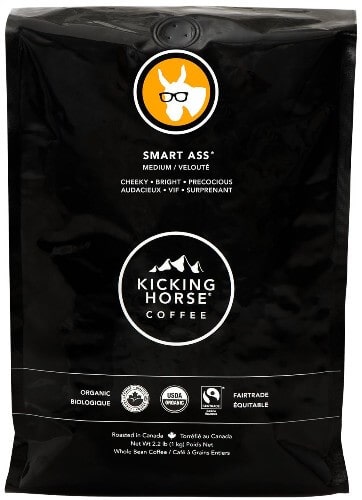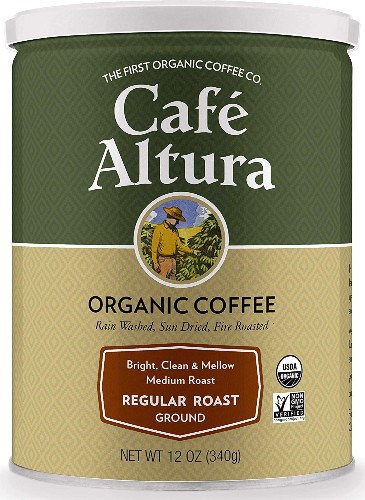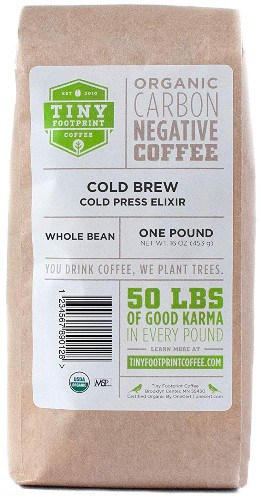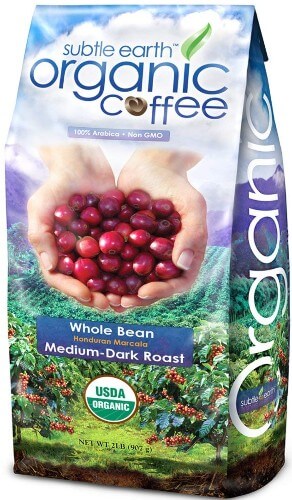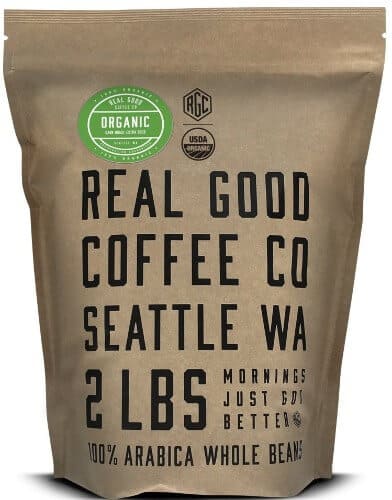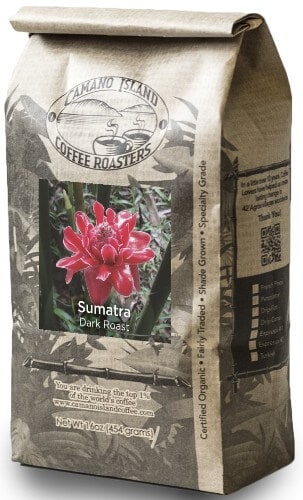7 Amazing Organic Coffee Beans That Hit The Sweet Spot For Coffee. Organic coffee beans have been the trend of the day, since the year 2010, actually, and a lot of people are now looking to buy organic coffee beans. Coffee houses are popping up on nearly every corner of any given city. Proving its growing popularity amongst the people. And with this rising popularity of coffee in general, consumers, including you, since you are reading this article now, are becoming more interested in this culture.
When you read this article you will realise that you have a lot to learn. There is so much that you can change in your coffee just by knowing the kinds of beans available in the market and using them the right way.
Because it is just that – a culture of coffee growers, consumers, distributors, and so on. Forming a community that helps and provides for each other. Or so it should be. But with knowledge comes responsibility. Not only towards your own good but also towards those who provide you with the much-loved black drink.
With the new growing tide towards coffee in the 21st century, coffee is back in its vogue. With coffee shops and restaurants around the corner, grabbing a cup is an easy task. However, if you are a health freak who wants tasty coffee at home, this article lists the organic coffee beans available in the markets to satisfy your health demands.
In this article, you can read the 7 organic coffee brands we have tried, tested, or researched. And enjoy useful information on what is organic coffee and why choose it. You will also learn how organic coffee is grown, processed, roasted, and decaffeinated. Here are some of the organic coffee beans for all the fitness freaks.
-
1.
Our 7 Organic Coffee Beans For All The Fitness Freaks
- 1.1. 1. Valhalla Java Ground Coffee by Death Wish Coffee
- 1.2. 2. Kicking Horse Coffee Smart Ass – WHOLE BEAN
- 1.3. 3. Cafe Altura Ground Organic Coffee
- 1.4. 4. Tiny Footprint Coffee Organic Cold Brew Cold Press Elixir
- 1.5. 5. Cafe Don Pablo Subtle Earth Organic Gourmet Coffee
- 1.6. 6. Real Good Coffee Co Organic Dark Roast
- 1.7. 7. Camano Island Roasters (Organic Sumatran)
- 2. Are Organic Coffee Beans Becoming a Craze?
- 3. What is organic coffee?
- 4. Growing organic coffee
- 5. Processing organic coffee
- 6. Roasting organic coffee beans
- 7. Organic Decaffeination Process
- 8. Why choose organic coffee?
- 9. Is it certified? (Make sure it is Organic coffee!)
Our 7 Organic Coffee Beans For All The Fitness Freaks
1. Valhalla Java Ground Coffee by Death Wish Coffee
Having trouble waking up in the mornings and noticing that your usual cup of coffee would not give you the kick that you need? Experience the power of Odin with the most potent Valhalla Java coffee in the world. Initially created for the guitarist Zakk Wylde this Death Wish coffee was created on the volcanic soil of Indonesia and Central and South America. This coffee will bring you a nutty taste with a sprinkle of chocolate that is both sweet and smooth and delivers a high amount of caffeine. One of the organic coffee beans there is.
One hundred per cent organic, approved by Fair Trade and USDA Certified Organic coffee. Death Wish coffee contains 728mg per 12 fl oz, which is nearly three times more than your average cup of coffee if that doesn’t wake you up nothing else will!
- Beans: Arabica & Robusta
- Dark roast
- Origin: a blend of classic Arabica and bold Robusta
Be aware – when brewing a cup of this coffee follow the instructions on the packaging or Death Wish website.
2. Kicking Horse Coffee Smart Ass – WHOLE BEAN
A Canadian brand that has gone full organic with all of its coffee brands grown organically. Certified by USDA Organic, Fairtrade Canada, KosherCheck, and EcoCert they take pride in having all of their beans sourced from organic producers. A coffee that is grown in the shade. And the Fair Trade certificate means that they care about the farmers, too. At Kicking Horse Coffee, they are serious about leaving a positive impact on the world around them.
This Kicking Horse Smart Ass coffee has a sweet syrup, vanilla bean, and stone fruit aroma, and the taste of red currant with a little bit of chocolate. You will love it when brewing for a French press, drip machine, pour-over, or cold brew.
- Beans: Arabica, Whole beans
- Medium roast
- Origin: Africa and Central and South America
You’ll love it if you have a bit of a sweet tooth when choosing your coffee!
3. Cafe Altura Ground Organic Coffee
Cafe Altura brings us some of the organically grown coffee beans there have since 1979. It is a family business that cares for its clients 100% and is USDA Organic, KSA Kosher & Non-GMO certified. It was the first organic coffee company in the United States. Cafe Altura offers you lightly roasted beans for a smooth, creamy taste. Safe to say that it is the way to start your morning – with a tasty cup of coffee that will ease you into your daily routine.
The part? They even offer a Ground-on-request service providing you with freshly ground coffee for a better taste. This option is available for all of Cafe Altera’s Organic, Fair Trade, and Biodynamic coffees.
The coffee comes not in packages, but in cans that are airtight and sealed. When ordering, you get to choose whether you want your coffee in the whole bean, or freshly ground.
- Beans: Arabica
- Light roast
- Origin: Chiapas, Mexico
Choose the Cafe Altura if you care about the customer service out there. Note – deliveries are available only in the United States.
4. Tiny Footprint Coffee Organic Cold Brew Cold Press Elixir
You drink coffee – they plant trees! That is the motto of Tiny Footprint Coffee – the first carbon-negative coffee in the world.
They make sure to take care of the environment that takes care of them and us. One pound of coffee you buy results in support of the Mindo Cloudforest region in Ecuador!
Do you care for a tasty cold brew cup of coffee, that is fully organic at that? Then Tiny Footprint Cold Press Elixir is just what you were looking for.
This 100% organic coffee bean brand will give you a sweet, silky rich taste with subtle bright fruit and floral tones infused in a cocoa-like body.
- Beans: Arabica
- Light + dark roast
- Origin: Ethiopia
It is roasted for the hipster side in you – with a vintage 90-kilo German-built Probat drum roaster!
5. Cafe Don Pablo Subtle Earth Organic Gourmet Coffee
They source their beans via family ties from the growing region, which assures that they, and therefore you, get the beans from every batch. Grown in high altitudes, they do not need any chemicals and are 100% organic coffee. As we already know higher elevations serve for better coffee, and this one is pretty much sky-high.
Roasting is another aspect of this shop that puts them above many others. They take special care and pride in it. They are dedicated to the slow roasting process that lures out the honey, cocoa, and caramel taste in your coffee. All the roasting is done in small batches. And every batch is watched over by a professional who uses his years of practice and mastery, to pull the beans at precisely the right moment.
Even more, to make sure that you get the most out of your coffee, they roast the beans on demand. Your coffee will be almost fresh when it reaches you. And you can feel the difference in the taste!
- Beans: Arabica
- Medium-dark roast
- Origin: Honduran coffee from the Marcala region
Don Pablo is one of those brands you fall for once you try it. Try it!
6. Real Good Coffee Co Organic Dark Roast
It truly is as stated the name – Real Good Coffee! It will fulfil your morning bringing the much-loved taste of truly great coffee.
The taste is saturated with a hint of spice and bold roasted notes and bell pepper, cedar, and lemony acidity. It will be just what you need to start your day, right?
Just try it, if you don’t like it – they will return your money, no questions asked. So give it a go!
- Beans: Arabica, whole beans
- Dark Roast
- Origin: Central and South America
Oh, and the customer service quality here really hits the spot!
7. Camano Island Roasters (Organic Sumatran)
They take pride in what they do and what they do is incredible! Thoroughly organic beans, they not only avoid using any chemicals, to protect nature and workers.
They go a step further by giving $1 per shipment to Agros International. When you buy their beans, you are changing a farmer’s future!
Freshness is of crucial concern for this shop, too. Each coffee purchase is shipped to you within 48 hours of roasting. The coffee itself contains little caffeine, if you were thinking about cutting that down – this is for you!
The taste is rich and full of complex fruit tones, nutty, sweet, and full-bodied. Perfect to have with your dessert.
- Beans: Arabica
- Dark and medium-dark roast
- Origin: Sumatra, Brazil, and New Guinea
Are Organic Coffee Beans Becoming a Craze?
The world is going crazy with consumerism, and people want more, more, and more products for a lesser price. Some things cannot, or should not, be manufactured in tens of thousands of kilograms. Such as organic coffee beans. While we can safely say that pot noodles fall within the first category, coffee, most definitely, does not.
Ecological balance, biodiversity, and support for food clear of chemicals are priorities for those who fall for the “Organic” seal products. But it also shows the respect we have for our world and the support we can give to those who embrace ways of producing clean products.
What is organic coffee?
Organic coffee is just what the name suggests – grown organically, without using chemicals to boost the harvest or speed up the process. But it does not only involve chemical usage but there’s also the way that organic coffee is grown.
With the rise of coffee consumption around the world, coffee plantation owners and producers are struggling to meet the ever-growing demand for more coffee. In October 2016, a total of 9.13 million coffee bags were exported around the world. Global coffee consumption levels in the year 2015-2016 have increased by 1.3% with around 151,3 million coffee bags consumed around the world. Each of these bags weighs 60kg (approximately 132.2 pounds).
Keeping up with the demand
To keep up with all the demand coffee producers started to induce the growing process chemically. That does not include only various chemical substances such as additives, pesticides, and herbicides. That also includes cutting down entire forests to make room for plantations. Organic coffee beans, in contrast to conventional coffee plantations, are grown in the shade of these forests. Instead of growing where forests once stood.
Those who take an interest in organic coffee beans are the ones who show that they care not only about their health but also about the environment. The support of organic bean producers by choosing organic over conventional helps planet Earth at large.
Various organizations around the world oversee the organic food growing processes and legislate what is considered “organic.”
Organic standards in the USA
In the United States, organic growing is overseen by the United States Department of Agriculture. This department sets the standards that organic coffee producers must meet before their products earn the organic label. For coffee producers to have this label (as in the picture) stamped on their beans, they have to meet the following criteria:

- The growing process can not involve any pesticides, herbicides, or fertilizers
- No less than 95 per cent of the beans have to grow under organic conditions
- The soil on which the plantation stands can not be contaminated with any chemicals for at least three years before the harvest
Many small organic coffee producers are small family businesses into organic coffee simply because they cannot afford to use any chemicals. However, the inspections that are necessary to receive the approval for their beans to be called organic aren’t cheap either. So, how do they get certified? Many nonprofit and for-profit organizations offer inspections to these businesses to receive the certificate.
Growing organic coffee
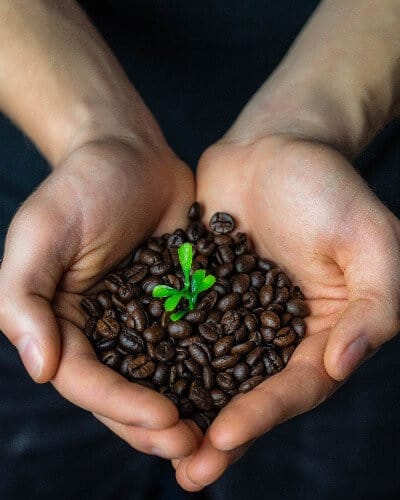
Growing organic coffee involves a lot more human resources work and cars than the conventional way. Since no pesticides or other chemicals are not allowed to receive the certificate, it is harder for the producers to keep and harvest the beans. Several standards must be met for the plantation owner before he can call his beans organic. And it surely requires a lot of love for what you do, to keep it up.
Conventional ways of growing coffee now and then
Conventional coffee growing, until the 1960s and ’70s, meant that the beans were grown organically. Since then, to increase the harvest and raise the volume of coffee-producing plantation owners started to use chemicals in the growing process. That is when the “conventional” way became one with chemically induced harvests, and organic growing became unconventional.
Shade-grown
Nowadays, organic coffee represents the old ways of growing and processing coffee beans for consumers. It involves shade-grown. Before coffee growing was industrialized, coffee producers would grow coffee in the shade of trees, thus – shade-grown. Since those plantations were hard to maintain and harvest, coffee is now grown in fields. However, when growing in the wild coffee can not withstand the heat of the direct sun. So, to be able to grow coffee in fields, the producers started to cross-breed the various coffee types. Creating varieties that are more resistant to the sun’s rays.
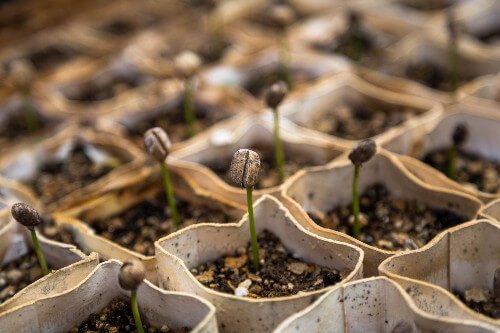
An upside of shade-grown versus growing coffee in fields? When plantation owners grow coffee in fields, they practice the conventional way of growing coffee, which includes various chemical substances to protect and enhance the harvest. Once the chemicals have done their work (or even before that), the rain falls. These chemicals are then absorbed by the soil and, with the help of rainwater, distributed throughout the land. The lack of trees also means that part of the good nutrients of the earth will be washed away. It is destroying the organic fertilizer of the lands. Not even mentioning all those forests that were destroyed to landscape the plantations.
No artificial chemical substances
Avoid of use of various chemicals and pesticides (with the exceptions of those being 100% organic). These producers take pride in their coffee being cultivated following traditional ways. But, being natural, in most cases, also means less volume, more manual labour, and higher expenses. Why only in most cases? Some producers can reach the same quantities as conventional coffee growers. However, that is mainly up to their process management systems and always involves more workforce.
The process is simplified for your experiments at home
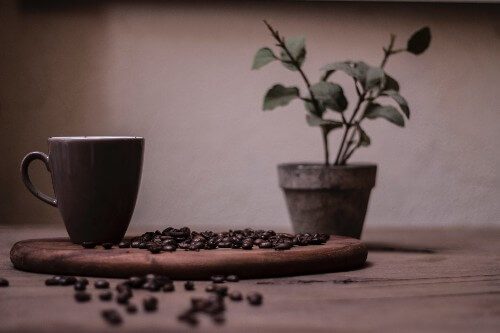
Once you have acquired some green beans for your coffee plantation, you ought to dry them out, just a little bit. After that – soak the beans in water for 24 hours, then plant the beans in wet sand or vermiculite. Once the seeds have germinated, plant them in soil, flat side down. You may add some organic fertilizer to help it grow stronger. Then cover the seeds, but do not stamp it down. You then need to water it daily, just enough to keep the soil damp.
It takes around three years for a coffee tree to grow to start producing coffee cherries. In 3 years – enjoy your very own grown coffee!
Processing organic coffee
It takes around three years for a coffee tree since it was planted, to grow and start to produce flowers. From these flowers come coffee cherries – the coffee fruits from which coffee beans are made. It takes around eight months since the flower blooms for the cherries to ripen. Once it happens, the coffee cherries are ready to be picked and processed.
There are two methods of processing coffee when organic coffee growing is involved. These are dry milling and wet milling. In the processing coffee beans are separated from the coffee cherries.
One of the most critical aspects of the processing of organically grown coffee beans is that every tool and facility used during the processes is fitted or adjusted for organic beans. For example – bags used to store and carry the beans are used only for organic coffee beans — any devices used in the process, too. Strict guidelines and rules are ensuring this. Otherwise, the producer can not receive the organic beans certificate.
Dry milling

Dry milling is the final stage of organic coffee production and is the oldest processing technique. It does not involve expensive machinery or a lot of resources, like water, as it is in the case of wet milling. Therefore it is much more cost-efficient and environmentally friendly. However, it takes more time.
Therefore it is most suitable for small producers. This method will provide organic coffee beans.
This process is necessary to remove excess layers of dry skin from the berries, then sort them and prepare for shipping. As the name suggests – this is done in a dry environment, which does not include using water to remove excess skin, leaves, and other dirt.
Once they harvest the cherries, they are laid out to dry in the sun (either artificial or real). After that comes the sorting process, where the unripe, overripe, and damaged cherries are sorted out of the good ones. They sort the cherries by hand. Then clean them off of excess skin, oil, and other residues.
The next step is to lay the cherries out in the sun for drying. To dry them out evenly, the cherries are turned by hand now and then, and the process can take up to one month. Drying is an essential processing step, as it will determine the quality and taste of the beans.
Wet milling
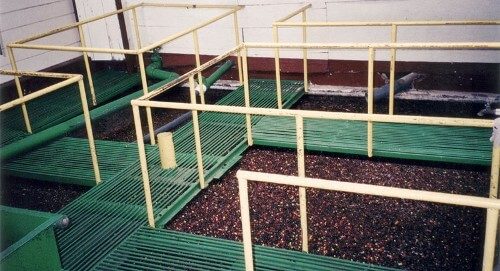
In the wet milling process, the beans are removed from the cherries before they are dried. Unlike dry milling, here the beans are sorted by immersing them in water. Cherries that are not ripe yet or are bad will float, leaving the good ones at the bottom.
After that, the cherries filter through a screen in the water. This step removes the excess skin and pulp.
After that, to remove any pulp that is left after the screening, the beans can be submitted to two different methods of cleaning:
1) Ferment and wash method
Using this method, the remaining pulp is removed by fermenting the beans with microbes which then break down the cellulose. After this process is finished, the beans are washed with a large amount of water to remove any microbes. The fermentation process has to be carefully supervised to ensure that the taste of the coffee is right.
2) Machine-assisted wet processing
With this method to separate the excess pulp, the beans are scrubbed mechanically, instead of using the fermentation. After that, the beans are left out in the sun to dry out, which makes it easier to remove any skin that is still attached to the beans and get them ready for shipping.
Roasting organic coffee beans
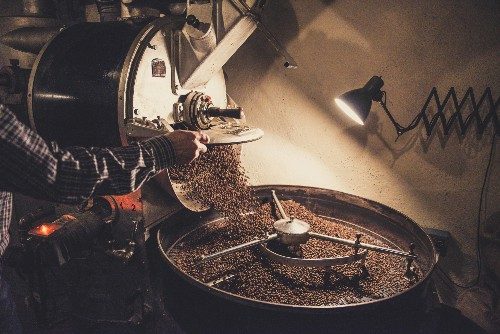
Roasting is not just heat added to coffee beans. There is so much more to it. Whether these are organic coffee beans that need roasting, or conventional. The process of roasting is an art that involves both – following precise guidelines for results. And some degree of experimenting and failures to get to the result and discover new flavours.
By submitting the green coffee beans to high temperatures, coffee roasters bring out the smell and flavour of the coffee beans as we know them and love them. There are four main roast types: light roast, medium roast, medium-dark roast, and dark roast. Each type represents the degree of roasting length the beans were submitted to. And each of them will taste various kinds of coffee.
What are the methods for roasting coffee beans?
There are ways to roast your coffee beans at home, too. The most common method is using a frying pan or an oven. Or you can go bigger and buy an electric coffee beans roaster, like the one below:
Coffee roaster types
There are two basic coffee roaster types: drum roaster, which is the oldest of coffee roasting methods. And Air roaster. Both roaster types can vary a lot regarding size and capacity, but the primary approach stays the same.
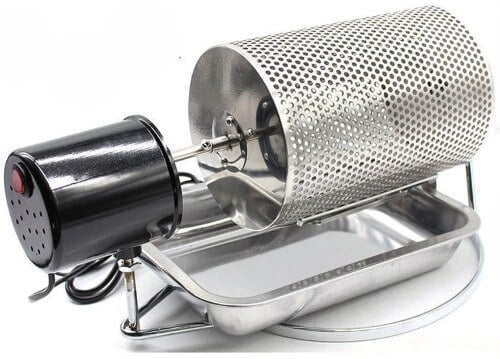 Drum roaster – where the coffee beans are loaded into a drum or a cylinder that is made out of metal and has holes on its surface. The roaster is then placed upon a heating system. It can be either gas or electricity or open flame, a grill, for example. The drum then rotates continuously and the beans are roasted until they reach the required degree of roast.
Drum roaster – where the coffee beans are loaded into a drum or a cylinder that is made out of metal and has holes on its surface. The roaster is then placed upon a heating system. It can be either gas or electricity or open flame, a grill, for example. The drum then rotates continuously and the beans are roasted until they reach the required degree of roast.
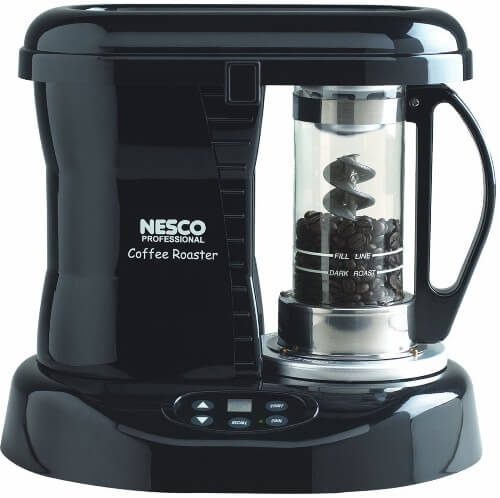 Air roaster – here the beans are loaded into a container, and then heated air is blasted through them to roast until ready.
Air roaster – here the beans are loaded into a container, and then heated air is blasted through them to roast until ready.
The temperature for the roast
The temperatures required to roast the coffee beans are quite high. They are starting from 370° degrees for light roasts to 580° for dark roasts. The heating temperature, combined with the amount of time of roasting is what leads to the perfect roast and taste of the coffee. Once the roasting is finished the beans are cooled down, to avoid any further heating effect on them. Afterwards – the beans are packed in vacuum packages to prevent losing the fragrance and coffee characteristics.
Practice makes it perfect
It takes a lot of practice, trial, and error to achieve excellence and master this art. However, that does not mean that you can not find roasting guides on the internet and follow them to get an excellent roast.
Light roast
When choosing a light roast, it is crucial to understand. The light coffee roast beans have the most acidity left from the coffee beans. Light roast also means that light roast coffee retains most of the original coffee characteristics. There is also no oil on these beans, as they are not roasted long enough for the oil to separate from the bean during the process. This coffee will taste fruity and floral and can bring a vibrant and unique taste.
Light roast varietals:
- Light City
- Half City
- Cinnamon
- New England
Medium roast
Favourite amongst Americans, this roast is a little bit darker than light roast. There is less acidity in it, and the surface of the bean should not be oily, too.
Types of medium roast coffee beans:
- City
- American
- Breakfast
Medium-dark roast
Tastes bittersweet, and due to the longer roasting time these coffee beans will have some oil on them. The taste still preserves some of the natural flavours of the coffee beans. Meaning, you can taste a bit of floral, grass, but thanks to the longer roasting time a touch of caramel is present, too.
Also known as:
- Full City
Dark roast
The dark roast coffee beans will have a dark brown colour and an oily surface as the roasting time is longer than any of the previous. This coffee roast won’t have any of the original coffee flavours of floral and fruits. The beans are oily due to the roasting time, which is longer than any of the previously mentioned roasts. The taste will remind you of chocolate caramel and nuts.
Dark roast coffee beans contain less acidity than any other roast type, too.
Other names include:
- Vienna roast
- Continental
- New Orleans
- European
- Espresso
- Italian
- French
Organic Decaffeination Process

So, you already know what organic coffee is by now, right? That’s coffee with no chemicals involved while it was grown – healthier for you, better for the environment, and better for the producers. But what if that is not enough for you? You know you love coffee. We all do, at least – to some degree. But you also know that organic coffee, much like conventional coffee, contains caffeine. Something that might not always be so useful for your health and might cause adverse health effects on you.
Organic coffee can be decaffeinated, too, without losing the much-loved characteristics of a good coffee. Even decaffeinated coffee will contain a minimal amount of caffeine. You can’t get rid of all of it because this process of removing caffeine chemical from the coffee bean is very complicated. A coffee bean contains over 1000 different chemical elements. The process to keep the balance of the taste and the quality of the bean is exceptionally complicated.
There are several methods to remove caffeine from coffee beans. All of them require to use of green coffee beans for this process. It is not possible to extract caffeine from roasted beans. All of these processes require water to be performed. Caffeine is a water-soluble substance. And a decaffeinating agent, like methylene chloride, activated charcoal, CO2, or ethyl acetate.
Roselius’ Process
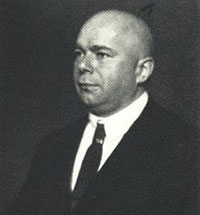 The first decaffeination process was invented by a German coffee business owner Ludwig Roselius. He discovered the decaffeination process by an accident while shipping the beans. One of the bags was soaked in seawater, which then resulted in coffee being decaffeinated. Roselius later replicated the process which involved soaking the coffee beans with saltwater and benzene. However, since the discovery of benzene being cancerogenic to humans, another method was due to.
The first decaffeination process was invented by a German coffee business owner Ludwig Roselius. He discovered the decaffeination process by an accident while shipping the beans. One of the bags was soaked in seawater, which then resulted in coffee being decaffeinated. Roselius later replicated the process which involved soaking the coffee beans with saltwater and benzene. However, since the discovery of benzene being cancerogenic to humans, another method was due to.
Swiss Water Process
Amongst all other decaffeination methods, this is the only one that is entirely organic. During this process, green coffee beans are repeatedly soaked in warm water and then pressed through a carbon filter which has been made from charcoal to extract the caffeine from the beans. Submerging the coffee beans in hot water allows the caffeine within the beans to come to rest on the surface of the bean, which then allows it to be removed using various techniques. This process can remove up to 99% of the caffeine from the beans. However, it can significantly affect the taste of the coffee.
Industrial Process
Coffee industries use a more sophisticated technique that allows the processing of higher quantities of coffee beans with better results while keeping most of the taste of the coffee. There are two types of industrial processes for caffeine extraction.
Direct
Here the green coffee beans are merged in hot water and then treated with Methylene Chloride or Ethyl Acetate. Then the beans are dried and submerged in hot water again, to remove the agents.
Indirect
This process is similar to the direct type of decaffeination. The beans are treated with hot water. Once the beans are removed from the water, Methylene Chloride or Ethyl Acetate is added to the water, and the beans are put back in it. Then the beans are dried off and treated with warm water again.
Carbon Dioxide Process
Here steamed coffee beans are soaked in liquid Carbon dioxide, or this dioxide is pushed at high pressures to the beans that are soaked in water. After that, the beans are pressed through a charcoal filter for removal of caffeine.
Coffee Oil (Triglyceride) Process
The process involves soaking coffee beans in warm water, then removing them and soaking them in coffee oil. The coffee oil contains triglycerides that extract the caffeine from the surface of the bean.
Why choose organic coffee?
Organic coffee brands are on the rise. More and more coffee houses and roasteries are now taking an interest in organic coffee. It is more expensive than conventional coffee and takes longer to produce. But it does help your health, the environment, and local or small producers to maintain their businesses. It enables them to continue providing you with high-quality organic coffee.
Healthier for you
Organic coffee is more robust for you to consume as there are no artificial chemicals involved in growing and producing the coffee. It has more antioxidants, vitamins, and minerals that are good for your health. And, since the soil on which it is grown is free of pesticides and other chemicals, the nutrients embedded in the coffee bean are all natural and healthy.
Not to mention the fact that it is also healthier for those who work in the coffee plantations. They no longer have to work with dangerous chemicals and pesticides.
Saves the environment (chemicals, growing in the shade)
As there are no artificial chemicals used to produce organic coffee beans, the soil on which it stands is way better than the conventional coffee plantations. Pesticides and other chemicals then not only absorbed by the coffee plants but also seep into the soil and are carried around with rainwater.
Initially, coffee trees would grow in the shade of a forest. However, as it is hard to maintain and harvest such plantations, producers have started to grow them in fields. That means – cutting down trees to make room for coffee fields. That brings an avalanche of additional problems. Like the degradation of the soil. The rainwater sweeps away nutrition elements and biological fertilizer.
Support local and small growers
An essential and necessary factor is the support for local and small organic coffee bean producers. They are often competing with large and industrialized conventional coffee producers that use chemicals in the process to grow more beans. Small business owners are left fighting with these giants. And, since there’s more workforce necessary and more time consumed, the costs can grow, leading to raised prices for organic coffee.
Also Read: Ground Coffee Brands | Coffee Beans For Cold Brew | Non-Coffee Drinker’s Guide | Nescafe Keurig K Cups | Instant Coffee Brands | Organic Coffee Beans | Kona Coffee Beans | Espresso Coffee Beans | Best Decaf Coffee | Best Coffee Beans for Cappuccino
Is it certified? (Make sure it is Organic coffee!)

If coffee is certified as organic, it will bear the “USDA ORGANIC” stamp on the packaging. To receive this certificate, the producer must follow a set of guidelines and requirements established by the USDA’s National Organic Program. The main conditions regulate that the soil, on which the coffee is grown, can not contain any chemical substances for a period of no less than three years.
No artificial chemicals can be used to enhance the growth of the beans. If the plantation grows both – organic and conventional coffee beans then a buffer space between the fields must be set. The producers must determine a clear growing and distributing plan accepted by the agency with clear indications of tools and services used, field borders, and so on.
It is only too obvious that organic brands take care of the planet as well and are not filled with artificial products that might guarantee a great taste but do more harm than help your health. It is always better to play it safe with a quality product that is guaranteed to make you feel great and be beneficial to your body as well.
Every organic producer must comply with the requirements, their fields, tools, and services must be subjected to certified examinators.
Besides the USDA, there are other certifications that a producer can obtain; however, those are mainly following general ecological criteria. If you see any of these stamps – you can be reasonably sure that they meet the conditions for “organic.”
Choose organic coffee brands (at least every once in a while)!


